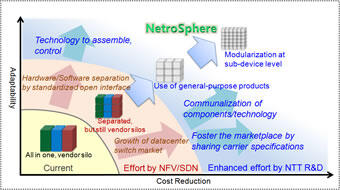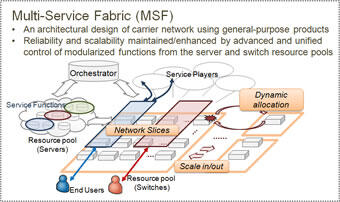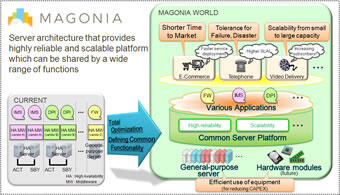Microsoft ends support for Internet Explorer on June 16, 2022.
We recommend using one of the browsers listed below.
- Microsoft Edge(Latest version)
- Mozilla Firefox(Latest version)
- Google Chrome(Latest version)
- Apple Safari(Latest version)
Please contact your browser provider for download and installation instructions.
February 19, 2015
NetroSphere: Towards the Transformation of Carrier Networks - A novel R&D concept to innovate the network development by accelerating network functions modularization -
Nippon Telegraph and Telephone Corporation (headquartered in Chiyoda-ku, Tokyo, CEO Hiroo Unoura, NTT hereinafter) has launched the "NetroSphere concept" as the new way to form the carrier network infrastructure. Instead of using conventional purpose-built high-functionality equipment, NetroSphere aims to divide them into small modular components, and flexibly assemble those components at will. This enables to quickly form proportional networks that can offer required functionality, capacity, and level of redundancy in accordance to the user's needs. As a result, carrier networks will achieve enhanced flexibility and elasticity while also drastically reducing costs.
As the key technologies to open the door of modularization and fabrication of network functions, NTT will work on the development of "MAGONIA" and "Multi-Service Fabric (MSF)." We expect that we can accelerate these R&D by open and worldwide collaboration with other carriers and vendors.
Background
In May of 2014, NTT announced the "Hikari Collaboration Model*1", which is the world's first full scale service wholesaling of fiber access. This announcement means that NTT will transform its business model to become a "Value Partner" that supports the creation of new services by a wide range of players. Although this is only one aspect, future carrier networks are required to be flexible and dependable not only for end users, but also for various business players that collaborate in creation of new type of services. Furthermore, in order to foster the appearance of innovative applications and services, the cost to use the network should be low enough so that its functionality, capacity and reachability can be fully utilized.
To simultaneously achieve flexibility and drastic cost reductions, we have concluded that there should be further exploration of the concept of applied virtualization technologies extended on their current trajectory, and that there should be transformation of the nature of equipment, networks and the entire surrounding communications industry.
The transitions targeted with the NetroSphere concept
Conventionally, network infrastructure has been built with purpose-built equipment specially designed for individual functions. Much of this purpose-built equipment is provided by particular vendors as all-in-one products that include the hardware, software and its operating system. To achieve the high level of reliability and performance required by carriers, each piece of equipment must contain various duplicate backup parts, must be fitted with system management functions such as monitoring and switchover, and must be big enough to handle large capacities. All of which leads to high power consumption, continued high prices, and difficulty in quick functional enhancement to respond to changing business requirements. In addition, large-scale systems where modules are tightly coupled have inefficiency in resource usage and system life span. Vacant resource of a module in a certain system cannot be shared with the other systems. The whole system may face EOL*2 even when a single sub-device reaches EOL.
The main idea in the NetroSphere concept is the division of functions. Not limited to decoupling software components from equipment, it pursues modularization as much as possible, ultimately at the sub-device level such as the CPU and memory. These modules will be distributed in locations that are optimal for each type of them, and prepared to be used as resource pool. Then, they will be virtually assembled to form a virtual system to provide required functions. In this way, we can offer network slices required by service providers.
Breaking up the functions of conventional large-scale equipment into modules will enable a greater diversity of suppliers to participate in the market and hence widen the selection of available products. Using modules as shared resources will enable more resource efficiency in achievement of required capacity and redundancy since the pieces can be added or removed to fit the demand proportionally, and can be focally replaced if they fail.
Approaches to achieving the NetroSphere concept
Emerging technologies driven by NFV*3 and SDN*4*3 is believed to help the modularization of network equipment. There is no doubt that the standardization effort for the open interface is essential for separating functional blocks. However, it is anticipated that the fruits for data centers cannot be brought about likewise for carrier networks. Even though equipment may be divided into blocks, but it may end up in a silo structure where all of those blocks are provided by the same vendor. Much less, we can hardly hope for fine granularity of modularization by just waiting for the progress of cloud technologies. Two major reasons why we cannot be optimistic are as follows. In the first place, design of the carrier network architecture normally begins with the fixed idea that the network functions are gathered in a single high-functional box such as core routers and edge routers. Secondly, carrier networks have special requirements such as high reliability and large scale in terms of number of users and dataflows, and nationwide coverage. And the fact that major vendors have a monopoly over technologies to cover those requirements results in making up the barrier for suppliers to provide small pieces as a part.
Thus, we are taking two approaches with our R&D to overcome these obstacles, as follows:
(1)Multi-Service Fabric (MSF)
MSF is an architectural design of carrier network in which functions are achieved using simple general-purpose servers and switches. Maintaining reliability and scalability is brought by advanced and unified control of modularized switch and server groups as virtual resources using inexpensive equipment. Although these ideas have already been used to achieve network configurations in some of the data centers, this will be the world's first attempt at application to a carrier network on a national scale.
Modeling of the modularized network structure enables better clarification of requirements for individual functional components such as switches and controllers. Moreover, opening the common specifications for these technologies promises the creation of markets, greater participation, and the commoditization of products.
A dynamic exhibit of MSF was showcased at the NTT R&D Forum 2015 held at the NTT Musashino R&D Center on February 19 and 20, 2015. Demonstrations included dynamic provisioning of network slices, and dynamic failover of virtualized network function running on distributed virtual machines in conjunction with changing packet transfer routes to reach the backup server. We have successfully shown the feasibility of the part of our concept, using currently available technologies and products.
(2)New Server Architecture (MAGONIA)
MAGONIA offers a highly reliable and scalable platform that can be shared by a wide range of applications. By opening these technologies and developments so that they are available to various vendors, no longer will the applications need to have specific built-in functions. Thus, new vendors will be able to get a foothold in the market much more easily. It may bring about wide variety of applications and the expansion of network potential is expected. By optimized assignment of network functions on servers distributed across a wide area, MAGONIA based network infrastructure will be resilient against failure, traffic fluctuation, and even against severe disaster.
Through the collaborative study*5*4 with our partners, we have exhibited at the SDN & OpenFlow World Congress 2014, performed field tests*6, and proven the concept of virtualized network functions proposed by ETSI NFV. Through these activities, we have verified the viability of the distributed processing base, which is responsible for high reliability and scalability that is the core of MAGONIA, and have set down API specifications (see
separate papers 1
,
2
).
Since we would like to see MAGONIA positioned as the basic architecture of future server systems, we are working towards standardization at ETSI NFV and others, and are promoting MAGONIA and its API among developers and service providers both in Japan and around the world.
Looking forward
In order to achieve the goal of NetroSphere, the business structure of wide range of players in the telecommunications industries should be changed. In this sense, we would like to collaborate with many partners, especially with other carriers that can share the same vision and common issues. We are willing to play an initiative role to develop uniform standards for common network functional requirements among carriers in order to create together the new market of modularized and general-purpose built products that can be used in future networks.
To accelerate these technical developments, we are linking up with a wide range of partners specializing in each of the key technical areas, such as vendors, universities and research institutes through joint research, PoC development, and experiments. For instance, in addition to the joint research*4 on MAGONIA, we have lead the development and interoperability test on Service Function Chaining (SFC)*5 in which we worked closely with five other companies worldwide.
About "NetroSphere"
NetroSphere is a technological concept advocated by NTT. The term comes from the following meanings: "Netro" - a prospect that stands upon the deep and wide knowledge of network development and operation which acquired in the past. "Sphere" - an image of networks that universally support our partners and customers just like the atmosphere cover and stand close to the life on earth.
Terminology
*1Hikari Collaboration Model: "Hikari Collaboration Model - Contributing to the Creation of New Value" - NTT press release May 13, 2014.
*2EOL stands for "End of Life".
*3NFV stands for "Network Functions Virtualization".
*4SDN stands for "Software Defined Networking".Collaborative study: Collaborative Study on Server Architecture for Future Networks (http://www.ntt.co.jp/news2014/1402e/140207a.html)
*5
Field test: Radio Japan broadcast contest (http://www.radiojapan.jp/contest/index.html ) (in Japanese)
*6 Development and interoperability test on Service Function Chaining lead by NTT: "World's first demonstration of interoperability of new IETF method for service chaining involving six companies," - NTT press release February 12, 2015.
Contact details for inquiries
Nippon Telegraph and Telephone Corporation
Information Network Laboratory Group
Planning Department, Public Relations Section
TEL: 0422-59-3663
Email: inlg-pr@lab.ntt.co.jp
Information is current as of the date of issue of the individual press release.
Please be advised that information may be outdated after that point.
NTT STORY
WEB media that thinks about the future with NTT














